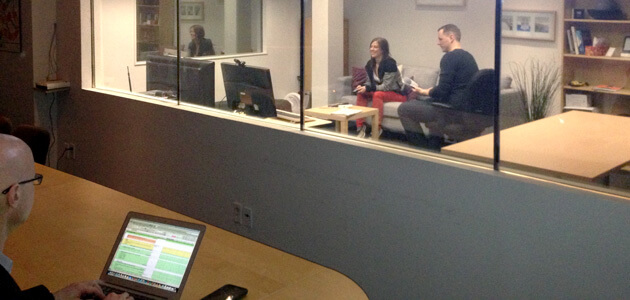
The value of in-lab usability testing

In recent years, the community of UX professionals have adapted their methodology to new trends in project execution. “Agile”, “Lean”, among others, have been the watchword, and activities related to user-centered design that formerly required weeks to be carried out from start to finish, now need to be done in a few hours or days.
In some cases, more elaborate user-centered design activities can result in a longer time to market, which can be a high risk to take in most markets. But everything in life is a matter of compromise, so what is gained in agility and low cost, is usually lost in depth, detail of analysis and likely quality as well. This is why we see such frequent new releases and updates these days.
One of the activities that have changed aggressively is usability testing. We increasingly choose to conduct rapid usability tests, even single-task sessions sometimes, using very simple and basic prototypes (often a pencil sketch of your screen), to obtain feedback from users as quickly as possible, improve the product and make new rounds of tests. This is good and helps eliminate a lot of potential problems in case you have had the chance to conduct some detailed user research to know your target audience well.
Many believe that with these new techniques, running usability tests in laboratory is no longer necessary. In fact, this type of testing still exists and will always exist. They give us the opportunity to dig deeper into the many issues a user might face when using a product and also dig deeper into the understanding of their behaviour, needs and expectations. Usability tests can be considered part of user research and getting some insight on users are essential to our work. In-lab usability tests allow us to better observe how the customers use the product and uncover irritating or useless features.
Here are some other advantages of laboratory tests:
1. Analysis beyond the screen: typically, usability labs are equipped with multiple cameras that allow you to capture details in body movement, posture, facial expressions, gestures, among others. This type of analysis is important because it reveals reactions that users will not express verbally, or contradictions between what the user says and expresses with his or her body. In a quick test, this kind of observation might be possible but it requires a much bigger effort from the moderator, which is not often able to make numerous observations and take notes at the same time without losing track of what the participant is doing or what should come next. Furthermore, the view of the moderator, or even someone who takes notes, does not always allow the participant to be observed in detail. Only a deeper analysis of the recordings, from different angles, will allow to observe all the nuances.
In Yu Centrik’s lab (see the image below), for example, we have two cameras mounted on the ceiling of the testing room. These cameras can be moved in all directions and zoomed on both the participant and the device being tested by a person who is in another room. Apart from the two cameras, we also have sensitive microphones, for capturing the voices of the participant and the moderator.
.jpg)
2. Real-time observation of the entire test environment: most often in rapid tests, we do not have a place for those who want to observe without interfering. We have, at most, the moderator and someone to take notes in the same room with the participant. The rest of the team and the client, if they want to observe, has to do it through live streaming software suites like GoToMeeting. A good usability lab has separate rooms for annotators and to the client, where they can observe the whole testing environment through one-way mirrors and also see the monitors, where they can watch what is being captured by the cameras. One of the great advantages of doing usability testing is that the client and the team that developed the product can see the reaction of real users. It is often enough to convince them that improvements are necessary and also earn up discussion time explaining the post-test problems because they saw them happen. Observing a usability test is an enriching experience that everyone involved in the project should live, and nothing like a good laboratory to bring this experience to the fullest. And the best people can observe, the richest the experience is.
3. A more controlled environment. Rapid tests are often improvised in environments which are subject to different kinds of interference and external distractions (noises, windows and the like), which may have a negative influence on the results of the evaluation. In a real usability lab we control the entire environment and can prevent all sorts of unexpected problems. Furthermore, we can adapt the laboratory environment in advance for the type of product being tested. For example, we can turn the lab into a living room to test an interactive TV product or in a hospital room for a medical device test.
4. Show that usability testing is serious and worth the effort. Although we have advanced a lot in terms of understanding the value of usability testing, they still are not seen by many as essential, and the return on investment is often questioned. The usability lab tests helps us show that testing is a serious activity and that, if done well, can reveal fundamental problems that will have a positive impact on business results. I’ve never seen, until today, a client who saw a usability test in our lab, questioning whether the amount paid was worth it, and not be impressed by the observations made.
Obviously, the choice of the type of test to perform depends on the context of each project and we must be flexible and have the necessary experience to make the appropriate choice. But often, the best choice is still the laboratory.
0 Comment(s)